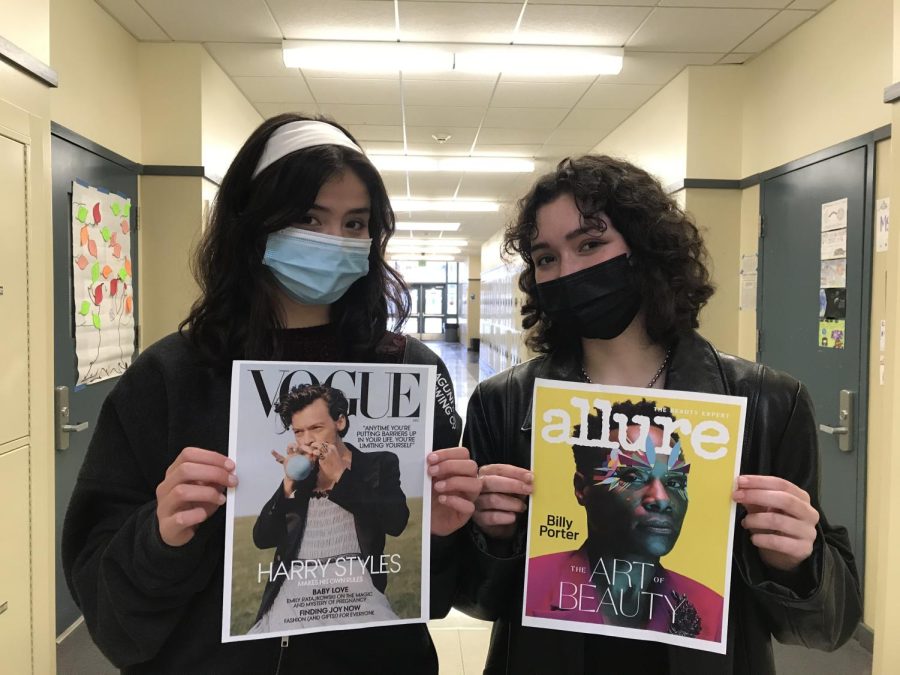Setting a Better Standard for Gender Representation in Fashion and Media
January 5, 2022
The name Harry Styles is known worldwide. Whether you were with your best friend in your room singing to One Direction’s “What Makes You Beautiful’,” or sitting in the car 10 years later listening to Harry Styles’s song “Golden.” Or maybe you’ve been living under a rock and don’t know who Harry Styles even is. Well, don’t worry about that. That’s my job: to present this ethereal man, and many others, to you. Harry Styles is a famous British singer who is known for his musical appearances, during his One Direction days and now as a solo artist.
On November 13, 2020, Vogue released an issue with an image of Harry Styles wearing a white, laced dress underneath a tuxedo jacket. This resulted in nationwide coverage and even a year later continues to be a conversation starter for many people at the dinner table. Many people and news publications such as CNN and Teen Vogue, referred to this as revolutionary and an inspiration for men to feel comfortable in expressing themselves through their clothing. Personally, I am a huge fan of Harry Styles and his music. When I first saw the Vogue cover, I loved everything about it. But it did get me thinking.
What about Billy Porter? Bretman Rock? BTS? The names I have mentioned are all famous POC artists, models, and influencers who are known for expressing their femininity through their clothing. But, where is their recognition?
I couldn’t help but wonder where that kind of coverage was for POC individuals such as Billy Porter. Billy Porter is a theatrical and musical star who has dominated the fashion industry with his luscious and wide variety of clothing. Porter is known for being one of the many POC individuals who express themselves freely through their clothing, feminine or masculine.
Porter had a lot to say about Styles’s Vogue cover. CNN wrote that Porter said “there was a disconnect in the opportunities afforded to him as a Black, gay man and those given to Styles.” I wholeheartedly agree with Porter. There is unspoken distance in representation which is overlooked by many, but not all.
“The Christopher Columbus Effect,” a term that San Rafael High School senior Adrian Rivers created, is making a global appearance more often than not in the 21st century. Essentially, the Christopher Columbus Effect is a theory where white individuals receive credit for things that were previously discovered and/or done by POC. In the case of men and them expressing their femininity, the Christopher Columbus Effect is very apparent.
“I think it’s important to have people who are not out or don’t label themselves as well to normalize men expressing their femininity,” says SRHS senior Nineveh Winton. Given how the public has responded to men expressing their femininity in the past, it’s clear there are mixed feelings in the crowd. If the press and media take the time to showcase these individuals in their own skin, whether they are cis men or a part of the LGBTQ+ community, the shame that they receieve will slowly decrease over time. It won’t be a rapid fix, but if there is a hint of normalization surrounding the topic, it’s one step forward.
I believe that despite what the general public has to say, people should be free to express themselves however they please. It shouldn’t matter what anyone else says, as long as you stay true to yourself. It breaks my heart whenever I see parents shaming their own children for wearing what they want and pursuing their interests. Sports, toys, movies, and literature should not be defined by what gender they are trying to appease to. When you are a kid, you are discovering and exploring the opportunities at your disposal. It’s the time where you learn more about yourself and who you are. No one should restrict that.
Oh, the media. There is too much to say about the media, especially film. There are roles in films that are not being filled by the right people. When a queer teenage male is depicted in film, the way their character is perceived is as someone who still dresses masculine, but speaks and acts in a different fashion. The same goes for the actors playing these characters, like in the movie “Love Simon.” You rarely see any drag queens, crossdressers, and/or transgender, let alone POC, women taking on leading roles in film or television.
In the same fashion, the award winning film The Danish Girl, starring Eddie Redmayne, is about a transgender woman, Lili Elbe, preparing to undergo one of her first sex-change operations. To me, the intention the director had in mind was genuine, but the execution could have been improved. Primarily, the actor who plays Lili Elbe is Eddie Redmayne. And guess what? He is a cis male. Is there a reason that the casting directors didn’t hire an actual transgender woman to play the role of Lili Elbe? If they want to cast and present these kinds of stories in an effective and authentic aspect on the big screen, there needs to be realistic representation.
In contrast, the HBO Max series, Euphoria, is a show about teenagers exploring their sexuality, love interests, handling their trauma and the struggles of drug addiction. The show does a spectacular job in their authentic portrayal of the characters in the show. Jules, played by Hunter Schafer, is one of the two lead characters in the show and personally, I absolutely love how they cast it. The casting director clearly understood who the characters were and the way they needed to be brought to life, especially Jules. The show follows Jules’ story through her life as a trans woman. Schafer is a transgender actress and model and has become a LBGTQ+ activist for the youth.
In an interview with Schafer in the New York Times, she talks about how much she relates to her character, due to her own personal experiences and that she “knew how I could bring that to her.” It’s moving to hear she isn’t just playing a character in a TV show and in addition, she put herself into the narrative. She added her own experiences to build the character and, in the duration of the show, she grew with Jules adding an emotional connection with the audience. Schafer has become someone that the next generation of youth will be able to look up to and aspire to be. “I feel like it inspires those who might be a part of the LGBTQ+ community to pursue what they’re passionate about without fearing that they may be judged or discriminated against by either cast members or audiences for their identity,” said Jason Ly, senior at SRHS, when asked about the impact that he’s seen Schafer have on the youth. She is, and will continue to be, an inspiration for all those impacted by her performances.
POC individuals have been discriminated against by others for generations, and it is still as apparent today. Whether they want to express their true selves through their clothing, or play characters on television who accurately depict who they are on a daily basis. These members of minority communities deserve the same recognition and praise as Harry Styles and all other cis men receive. As SRHS junior Ronny Garcia-Calderon simply states: “be true to yourself,” which is a lesson that everyone should take in.
The parameters of masculinity isn’t as much of a global issue as some may assume. It’s primarily a westernized concept. South Korean boy band, BTS, have broken international barriers by wearing feminie clothing for various photoshoots, their album promotions, and magazine covers. Why is this relevant you may ask? Well, it’s common in South Korean pop culture for men to wear dresses, skirts, and makeup. BTS and many other K-pop groups have influenced the younger generation to wear what they want without fear. This is Korean media. If these countries halfway across the world can accept men expressing themselves for who they are, why can’t America?
As Rivers puts it, “Men have been wearing feminine clothing for centuries, so it isn’t that revolutionary. So don’t treat it as ‘Oh My God! A Man Wearing A Dress!’”







































Maureen G • Jan 15, 2022 at 4:43 pm
I read all three of your pieces, Elisabeth. Not only are they well written and thoughtful, I loved your choices of subject matter. All different, timely, poignant and personal.